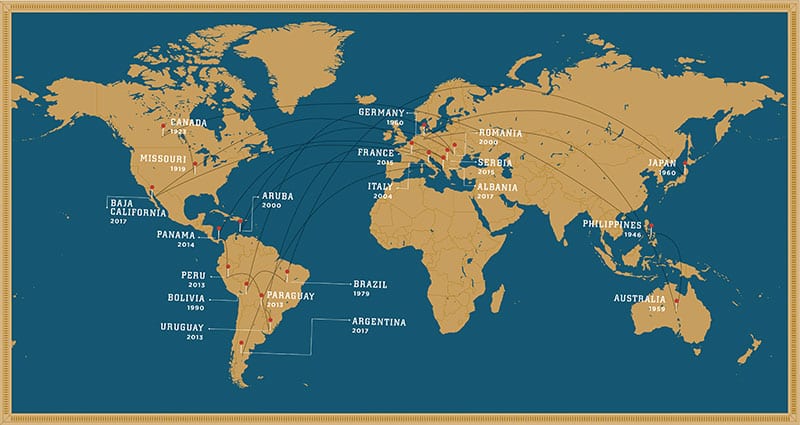
From Missouri To The World
Track DeMolay’s expansion from the United States to Canada, Europe, and beyond.
By Laura Benys
Two or three times a week, 17-year-old Brett Grimm finishes afternoon classes at his high school in Reno, Nevada, climbs behind the wheel of the family car, and heads west for California. On the long drive – anywhere from one and a half to six hours – he’ll return phone calls, mentally prepare for upcoming events, and if all else fails, listen to music. When he arrives at his destination, he’ll spend a few memorable hours meeting with young men who have spent months planning for his visit. At the close of an evening filled with ritual, service, and friendship, he’ll turn around and make the drive back. Many days, he won’t pull into his driveway in Reno – where he lives with his parents, twin brother, and younger sister – until one or two in the morning. He spends more weekends in California than Nevada. He doesn’t know how many miles he’s logged on the road. “I stopped counting when I saw the look of concern on my parents’ faces,” he jokes.
Grimm is a leader in DeMolay, a character-building and leadership organization for young men ages 12 to 21. The youth order, which is part of the extended Masonic family, is having a big year: 2019 marks its centennial anniversary. The milestone is being celebrated in chapters in 25 countries around the globe, including about 15,000 active members in the United States and Canada alone.
In addition to being a full-time high school student and treasurer of his junior class, Grimm is serving in the highest office of the DeMolay jurisdiction of Northern California, Hawaii, and Northern Nevada. (And for the record, his parents are incredibly supportive; his dad has been so inspired, he’s currently going through his own Masonic degrees.) As jurisdictional master councilor, Grimm’s responsibilities include traveling with fellow officers to each local chapter to check in on their programs, find out what kind of support they need, and make lifelong connections. This is where the long days on the road come in. Grimm doesn’t mind a bit. “It’s a pretty beautiful experience,” he says. “After an event, young men have reached out to ask questions or talk about something personal, whether they’re having trouble at school or anything else. They trust in you when they talk about these things, which is exactly what we want them to do. It means we’re doing our job right.”
Like many young men who join DeMolay (and for that matter, Masonry), he didn’t always imagine himself as such a role model and all-around leader. Being in DeMolay showed him that he could be.
“I used to think that being a jurisdictional leader was way beyond what I could do,” he says. “But as time went on, my chapter gave me opportunities to grow. The older DeMolays helped me come out of my shell. My advisors were always motivating me to take a step forward. DeMolay helped me grow from a timid young man into who I am today.”
From time management to public speaking to event planning, the skills Grimm learns in DeMolay will be valuable throughout his life, priming him to be a leader at almost anything he tries. But within the day-to-day activities of the youth order, he has also been practicing something else, which will make him the very best kind of leader to have: strong values.
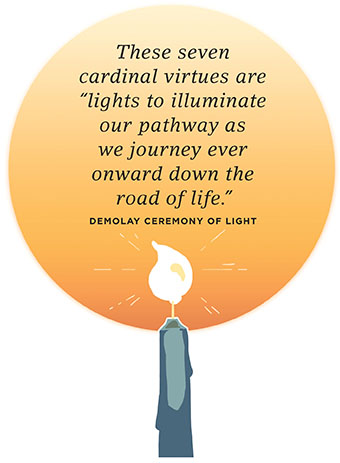
Sometimes, at a public occasion where it’s appropriate to summarize the basic teachings of DeMolay, one or a few members will perform a short ritual called the Ceremony of Light. In it, seven candles are lit to symbolize the youth order’s seven cardinal virtues: love of parents and family, reverence for sacred things, courtesy, comradeship, loyalty, cleanness (including respectfulness in thoughts, words, and actions), and patriotism. They are “symbols of all that is good and right with the world.”
“We live in troubled times…” the ritual explains, “in danger of sinking into the waste of doubt and uncertainty… when trust and justice and brotherhood may not be considered the most virtuous of qualities…” But these seven cardinal virtues are “lights to illuminate our pathway as we journey ever onward down the road of life.”
In 1919, when DeMolay was first created, the world had indeed seen troubled times. Nations around the globe were recovering from the horrors of World War I, and the tens of millions of lives that had been lost. Americans looked to each other to reclaim some sense of strength and stability, embracing community activism and social institutions like never before. Membership in organizations like Freemasonry soared.
During this time, Frank Land, a Freemason in Kansas City, Missouri met a young man whose father had recently died. Land had hired 16-year-old Louis Lower to do odd jobs around the local Scottish Rite building, but soon he saw that the teenager needed more than employment: He needed the support of adult males, and a wholesome environment where he could learn skills, serve his community, and have fun. Many of Lower’s friends were also fatherless, and Land had an idea that could help them all. He had Lower round up eight of his friends, and together, they made plans for a boys club. The young men named themselves the Order of DeMolay in honor of Jacques DeMolay, a Templar Knight martyred in the Middle Ages for refusing to betray his friends. The first meeting was held on March 24, 1919, attended by 31 local boys.
DeMolay – and the other Masonic youth orders that followed, namely Job’s Daughters and Rainbow for Girls – was among a growing number of youth organizations in America in the 1920s, including church groups and clubs like the Boy Scouts and Girl Scouts. But the Masonic youth orders were unique, in part because they incorporated symbolic rituals like the Ceremony of Light. Inspired by Freemasonry’s initiatic process, Land had a friend and fellow Mason write the ritual for two DeMolay degrees and a host of other ceremonies. Sure enough, the symbolism, pageantry, and solemnity ingrained in the youth order’s rituals captured the young men’s imaginations, and sealed the bond between them.
DeMolay’s rituals and welcoming environment immediately appealed to young men, who began joining in droves, and its lessons in virtues and good citizenship were readily embraced by American society. Chapters sprang up throughout the United States, then in Canada, and by the 1960s, around the globe. Today, it has enriched the lives of more than 1 million young men worldwide.
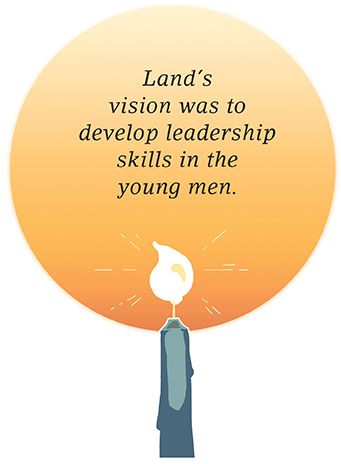
But its lessons don’t end with a discussion of morals. From the beginning, Land’s vision was to develop leadership skills in the young men by empowering them to lead themselves. The members elect their own officers to run meetings; discuss and vote on decisions; and plan their own activities. Older members act as mentors to younger boys.
Each chapter is sponsored by a local Masonic lodge or appendant group, which provides adult volunteers – who are both men and women, and needn’t have a Masonic connection – to serve as advisors. They’re integral to a chapter’s success, but their role is largely in the background, leaving the overall direction and operation of each chapter to the young members.
This approach prepared Avery Brinkley for his current responsibilities as DeMolay’s international master councilor. When Brinkley first encountered DeMolay in Southern California at age 14, he was “super shy,” he says. His cousin dragged him to an event, and at first, he didn’t consider joining because “I knew it would make me have to talk to other people.” Then he saw a public installation ceremony that featured the “arch of steel,” a processional and recessional framed by two columns of older DeMolays, who draw swords and hold them aloft in an arch. That did it, Brinkley says: “I was like, Where do I sign up?” He came up through Yorba Linda Chapter.
It’s funny to him to think back to a time when he was afraid of talking. Now, it’s one of his main responsibilities. At age 21, Brinkley is serving a one-year term as the head of the global organization of DeMolay International, traveling to chapters around the world to promote the youth order and celebrate the centennial. A little while ago he was in Boston manning the phones in a telethon fundraiser, then traveled straight to Ohio for the jurisdiction’s “WinterFest” convention, then a few days later headed to Paraguay for a special countrywide initiation: 100 new members were initiated in honor of DeMolay’s 100 years. Suffice it to say, his travel calendar is booked. (When he was installed in his office in June, he signed up for a frequent flyer account, and it took less than five months to rack up the 30,000 miles for gold status.) In any spare time, whether on the ground or up in the air, he works on his speeches, reviews the upcoming agendas for numerous committees, and replies to an ongoing stream of DeMolay emails. He spends hours each day discussing DeMolay business with his international congress secretary and leading adult advisor, and juggles conference calls scheduled across time zones with about nine youth committees.
“It’s a job,” he says. “I have to really have a good grip on time management. I have to make sure that I’m delegating.”
One of his primary initiatives is to create a year-round membership drive on the international level. He’s also passionate about improving the youth order’s use of social media and technology: DeMolay International launched an app in January, and has energized its social media presence, now posting daily on popular platforms like Instagram. The increased activity has already attracted new members, brought back others who had drifted away, and increased overall energy and enthusiasm for DeMolay. He’s also excited about launching a variety of member surveys, aimed at strengthening chapters and improving the DeMolay experience around the world. He and his fellow leaders are confronting the same question that Masonic lodges ask every day: How to evolve for modern times while still preserving what’s most important?
“We’re changing our marketing, and how young men find out about DeMolay,” Brinkley says. “We’re changing how the members get involved: They used to get together to play baseball, now they might play video games. But the experience they have in DeMolay, the bonds that they make – that’s not changing.”
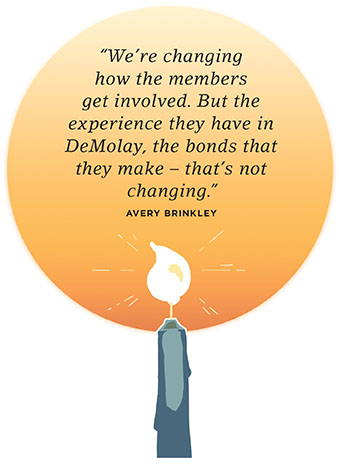 Neither are the values. “It’s important to educate the youth of today on morality and our obligations to each other. I think that everybody who joins DeMolay realizes that they’re getting something out of it that they could not get anywhere else,” Brinkley says. “Our ideals are ageless and timeless. That’s why DeMolay still has a place in our society. That’s why I think it will carry on forever. The fact that we’re reaching 100 years is concrete proof of it.”
Neither are the values. “It’s important to educate the youth of today on morality and our obligations to each other. I think that everybody who joins DeMolay realizes that they’re getting something out of it that they could not get anywhere else,” Brinkley says. “Our ideals are ageless and timeless. That’s why DeMolay still has a place in our society. That’s why I think it will carry on forever. The fact that we’re reaching 100 years is concrete proof of it.”
As he travels to chapters around the world, he reminds the young men of DeMolay that they’re now part of the legacy. “We need to lay the foundation for the next 100 years of DeMolay,” he tells them, “and the next hundreds of 100 years.”
The age range for DeMolays, 12 to 21 years old, coincide with some of the most formative years in their lives. During this time, they affirm and reaffirm their commitment to the seven cardinal virtues – in the words of the Ceremony of Light ritual, “the standards upon which we as DeMolays have pledged to base our lives.” Such promises, repeated again and again to dear friends and trusted adults, make a lasting impact. It’s no wonder that DeMolay alumni have a habit of leading inspirational and value-driven lives, and have risen to prominence across all industries and sectors of society; this roster includes Walter Cronkite, John Wayne, John Steinbeck, Paul Harvey, Fran Tarkenton, John Cameron Swaze, Bob Mathias, Burl Ives, and Mark Hatfield.
William Hoover is on this list. At age 29, Hoover is the recipient of some of the military’s highest honors for bravery, including the Purple Heart, the Army Meritorious Service medal, and the bronze star. While deployed in Afghanistan as a sergeant in the U.S. Army, he was shot nine times while shielding three other officers from an assassin’s bullets. He saved their lives, and almost lost his own.
Hoover is originally from Sacramento, where he was raised by his grandmother and mother. When he discovered DeMolay (by accident – he and his mother were lost and stumbled into a youth order event), it gave him a family of another kind.
“My dad wasn’t in my life, so the dad advisors played a big part in turning me into the man I am today,” he says, “teaching me the DeMolay core values, teaching me how to be a good man and a good member of society.”
When the attack happened in Afghanistan, he says, those lessons flashed through his mind. “When you’re in a state like that, your mind reverts back to what it knows best. DeMolay had been drilling those lessons into me for years, to think about everyone else first and think about yourself last,” he says. “I honestly don’t know if, without DeMolay, I would’ve had the strength of character and the strength of mind to do what I did.”
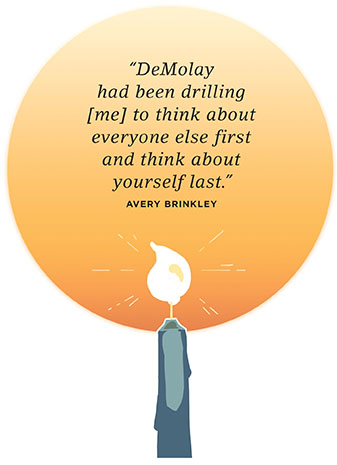 Few DeMolays will ever be tested as Hoover was on that day. But there are other kinds of battles, and other kinds of tests, whether it’s navigating the hallways of a high school, standing in front of a boardroom, or simply treating others with respect.
Few DeMolays will ever be tested as Hoover was on that day. But there are other kinds of battles, and other kinds of tests, whether it’s navigating the hallways of a high school, standing in front of a boardroom, or simply treating others with respect.
None of these is easy – which is why the Ceremony of Light concludes by imploring each member to embody the seven cardinal virtues every day, and to inspire others to do the same. “[E]ach of you, as a DeMolay, holds within your heart a flame, a beacon to guide you through the darkness. If you can make this light shine upon another, if you can reach into the innermost depths of his soul and set his flame afire, then therein lies the purpose of the Order of DeMolay, and therein lies your purpose for living.”
In 2017, Hoover was inducted into DeMolay International’s Hall of Fame for his heroism. These days, one of his favorite things to do is travel to DeMolay events to speak with members. He talks about how DeMolay taught him how to be a leader who encourages rather than intimidates, and how important that approach was when he joined the military. He shares how much support NorCal DeMolay and his Masonic lodge, Sacramento Lodge No. 40, have given him during the long recovery from his injuries. He says that once you’re a DeMolay or Mason, your brothers “will always have your back.” He tells them that the values they are learning in DeMolay make them who they are – and that, in turn, will affect the lives of everybody they touch.
Hoover recently gave a speech at Minnesota DeMolay’s centennial celebration. It had been a heartening weekend, leaving him with the sense that DeMolay was as vibrant as ever, and poised for a great future. When he took the stage to speak, he could make out individual faces in the audience. “I love when I can see everybody’s faces,” he says. “When I’ve said something that hits one of the DeMolay’s hearts, and his face lights up, I think, ‘I got to him.’”
Longtime members and new brothers can use these questions as the starting point for a discussion in lodge, or in one-on-one conversations.
Above:
Members of DeMolay and Rainbow for Girls
Editors Note: Mark Frauenfelder is research director of the Institute of the Future, editor-in-chief of Cool-Tools.org, cofounder of Boing Boing, and founding editor-in-chief of MAKE magazine. A longtime contributor and former editor of WIRED magazine, he was the founding editor of Wired.com. He is also the author of eight books.

Track DeMolay’s expansion from the United States to Canada, Europe, and beyond.
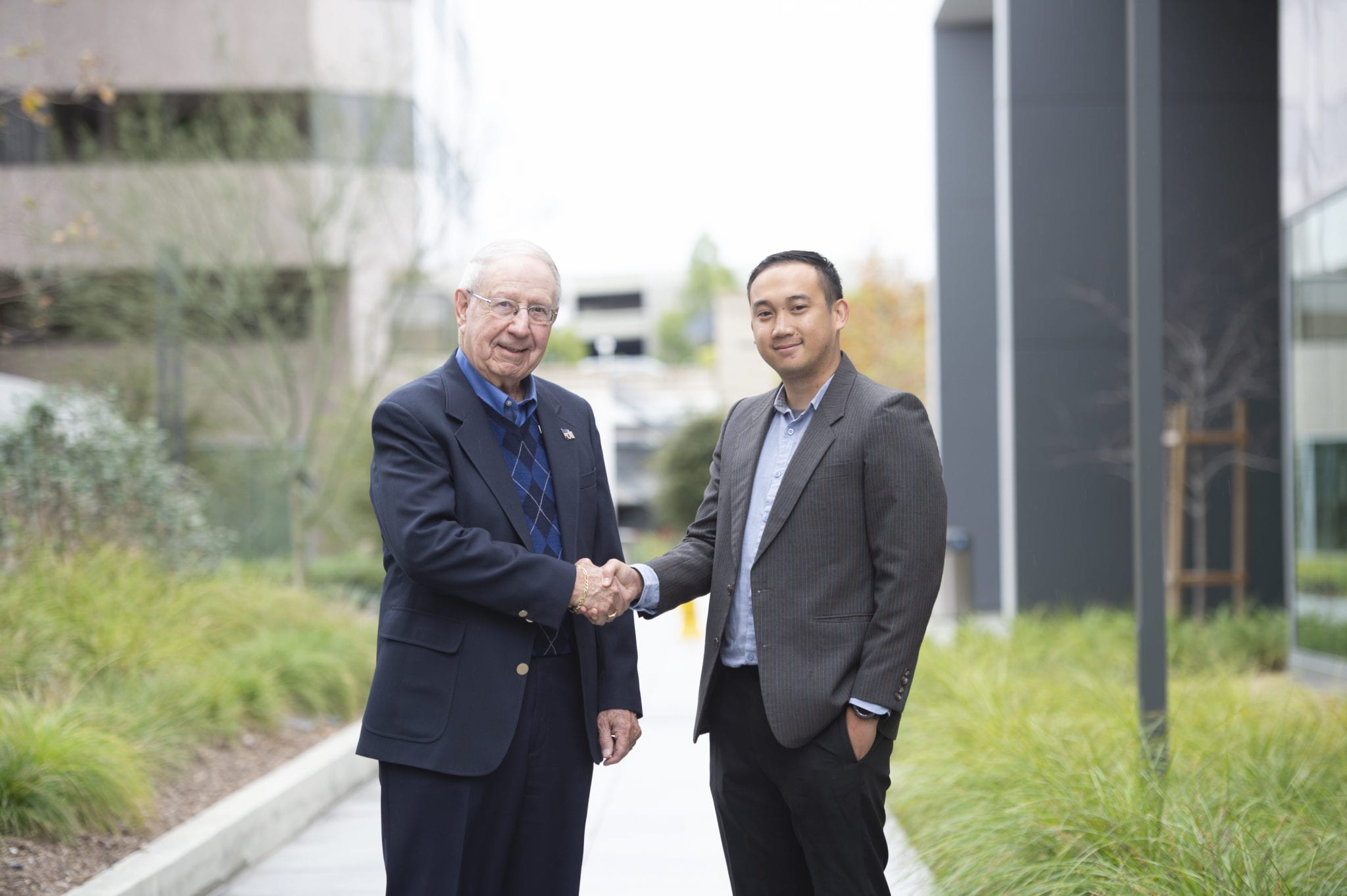
Two senior DeMolays, and current Masons, share their impactful experiences and perspectives of these Masonic fraternal orders.
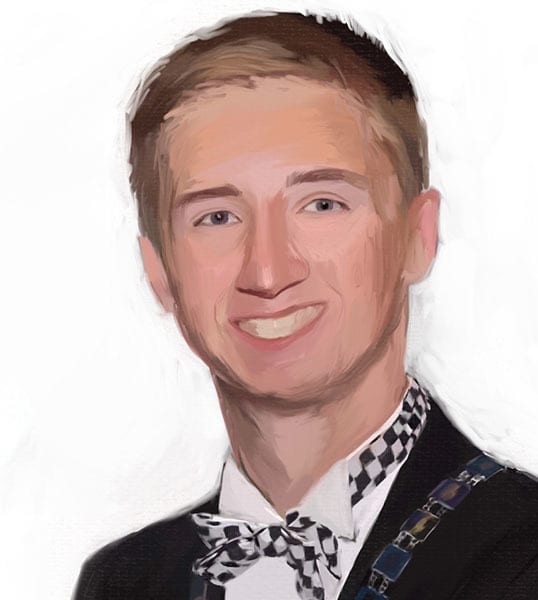
This winning essay by DeMolay member Jake Vermeulen addresses the enduring important of DeMolay.